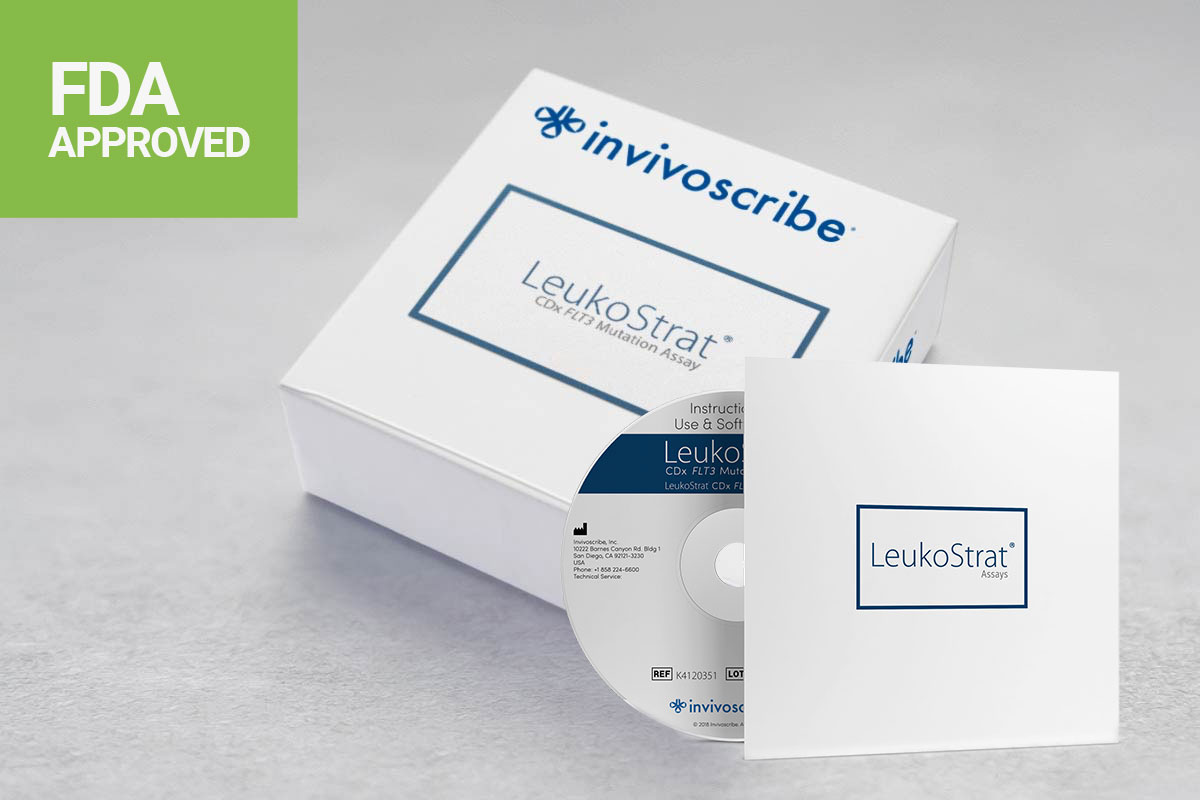CAT #: K4120361
LeukoStrat® CDx FLT3 Mutation Assay
Intended Use
The LeukoStrat® CDx FLT3 Mutation Assay is a PCR-based in vitro diagnostic test designed to detect internal tandem duplication (ITD) and tyrosine kinase domain (TKD) mutations D835 and I836 in the FLT3 gene in genomic DNA extracted from mononuclear cells obtained from peripheral blood or bone marrow aspirates of patients diagnosed with acute myelogenous leukemia (AML).
The LeukoStrat® CDx FLT3 Mutation Assay is used as an aid in the assessment of patients with AML for whom RYDAPT® (midostaurin) treatment is being considered.
The LeukoStrat® CDx FLT3 Mutation Assay is used as an aid in the assessment of patients with AML for whom XOSPATA® (gilteritinib) treatment is being considered.
The LeukoStrat® CDx FLT3 Mutation Assay is used as an aid in the assessment of patients with FLT3-ITD+ AML for whom VANFLYTA® (quizartinib) treatment is being considered.
The test is for use on the 3500xL Dx Genetic Analyzer.
Product Details
-
Summary and Explanation of the Test
The LeukoStrat® CDx FLT3 Mutation Assay is the companion diagnostic to RYDAPT® (midostaurin), XOSPATA® (gilteritinib), and VANFLYTA® (quizartinib) in the United States (US). This assay is FDA approved, and provides a critical tool for healthcare providers to identify the most appropriate treatment for newly diagnosed or relapsed/refractory FLT3 mut+ AML patients.
• RYDAPT® is approved as treatment for adults with newly diagnosed FLT3-ITD and FLT3-TKD mutated AML.
• XOSPATA® is approved as treatment for adults with relapsed/refractory FLT3-ITD and FLT3-TKD mutated AML
• VANFLYTA® is approved as treatment for adults with newly diagnosed FLT3-ITD mutated AMLThis assay was first released as a service by LabPMM, LLC and is now available as a kit (PN K4120361) for purchase. This IVD kit includes reagents along with software that interprets data, generates mutant/wildtype signal ratios, and predicts response to gilteritinib, midostaurin, and quizartinib. With a defined workflow, this assay is simple to implement in laboratories for in-house FLT3 testing with rapid turn-around-time.
This assay targets regions of the FLT3 gene to identify internal tandem duplication (ITD) and tyrosine kinase domain (TKD) mutations, such as the D835 and I836 mutations. DNA is amplified via PCR and the amplicons are detected via capillary electrophoresis FLT3 mutation status is determined by the LeukoStrat® CDx FLT3 Software. Acceptable patient specimens of peripheral blood or bone marrow may be preserved in EDTA or NaHep.
-
Principles of the Procedure
Internal Tandem Duplication (ITD) Mutations of FLT3
FLT3 ITD or length mutations are caused by duplication and insertion of a portion of the FLT3 gene that includes the region in and around the juxtamembrane (JM) region of the FLT3 gene. These mutations vary in both the location and the length of the inserted duplicated DNA sequence. ITD mutations result in constitutive autophosphorylation and activation of FLT3.
The LeukoStrat®CDx FLT3 Mutation Assay uses primers that are in and around the JM region. The forward and reverse PCR primers are fluorescently labeled with different fluorophores that serve to confirm the presence of sample signal. Wild-type FLT3 alleles will amplify and produce a product measured at 327±1 bp as measured by this assay, while alleles that contain ITD mutations will produce a product that exceeds 327±1 bp (Figure 1).
Tyrosine Kinase Domain (TKD) Mutations of FLT3
FLT3 TKD mutations are caused by nucleic acid substitutions and/or deletions that result in a change in the amino acid sequence in this highly-conserved catalytic center. TKD mutations, such as D835 and I836 substitutions and deletions, result in constitutive autophosphorylation and activation of FLT3.
The LeukoStrat CDx FLT3 Mutation Assay uses primers that lie on either side of the TKD region. The FLT3 target region is amplified using PCR and then an EcoRV restriction digest is performed. Wild-type alleles of the FLT3 gene yield digestion products of 79±1 bp whereas mutant alleles yield products of 125±1 bp or 127±1 bp from the original undigested amplicon product of 145±1 bp or 147±1 bp, as measured by this assay (Figure 1).

Figure 1: Depicted is a representation of the FLT3 juxtamembrane (JM) region (TM = transmembrane) and the activating loop of the tyrosine kinase (TK) domain. Black arrows represent the relative positions of primers that target in and around the JM region for ITD or the activating loop of the kinase domain for TKD. Colored dots represent fluorophores on labeled primers. The yellow box has vertical black lines that represent the position of the EcoRV restriction digest sites.
Disclaimer
These IVD products are intended for in vitro diagnostic use, and are available for sale or use within the United States only.
Legal Notice
Use of this product may require nucleic acid amplification methods such as Polymerase Chain Reaction (PCR). Any necessary license to practice amplification methods or to use amplification enzymes or equipment covered by third party patents is the responsibility of the user and no such license is granted by Invivoscribe, Inc, expressly or by implication.
© 2023 Invivoscribe, Inc. All rights reserved. The trademarks mentioned herein are the property of Invivoscribe, Inc and/or its affiliates, or (as to the trademarks of others used herein) their respective owners.

 US
US 
